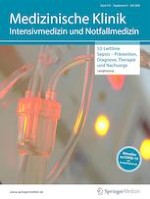Erschienen in:

30.04.2020 | Septischer Schock | Leitlinien und Empfehlungen
S3-Leitlinie Sepsis – Prävention, Diagnose, Therapie und Nachsorge
Langfassung
verfasst von:
Prof. Dr. med. F. M. Brunkhorst, M. A. Weigand, M. Pletz, P. Gastmeier, S. W. Lemmen, A. Meier-Hellmann, M. Ragaller, A. Weyland, G. Marx, M. Bucher, H. Gerlach, B. Salzberger, B. Grabein, T. Welte, K. Werdan, S. Kluge, H. G. Bone, C. Putensen, R. Rossaint, M. Quintel, C. Spies, B. Weiß, S. John, M. Oppert, A. Jörres, T. Brenner, G. Elke, M. Gründling, K. Mayer, A. Weimann, T. W. Felbinger, H. Axer, Deutsche Sepsis Gesellschaft e. V.
Erschienen in:
Medizinische Klinik - Intensivmedizin und Notfallmedizin
|
Sonderheft 2/2020
Einloggen, um Zugang zu erhalten











